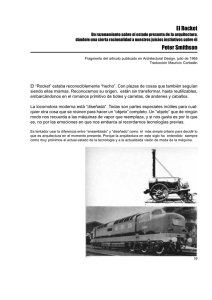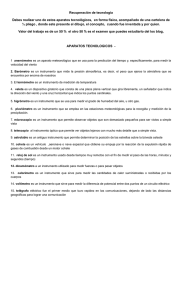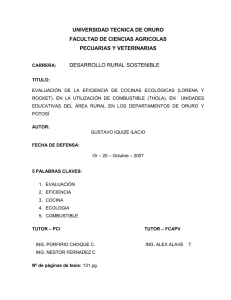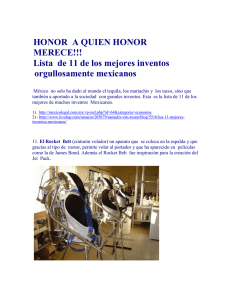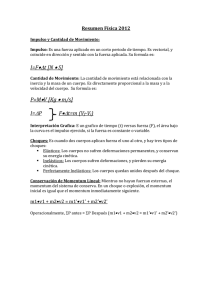Dinámica de los sistemas de partículas
Anuncio
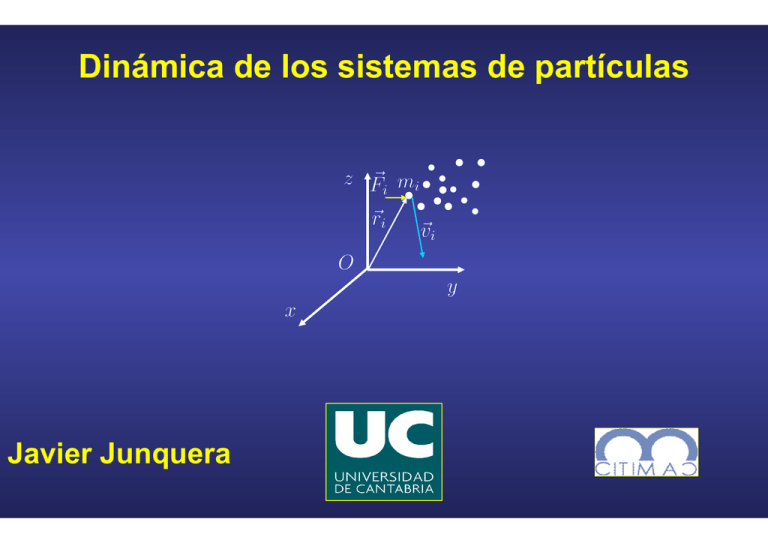
Dinámica de los sistemas de partículas Javier Junquera Bibliografía FUENTE PRINCIPAL Física, Volumen 1, 3° edición Raymod A. Serway y John W. Jewett, Jr. Ed. Thomson ISBN: 84-9732-168-5 Capítulo 8 Física para Ciencias e Ingeniería, Volumen 1, 7° edición Raymod A. Serway y John W. Jewett, Jr. Cengage Learning ISBN 978-970-686-822-0 Capítulo 9 Tips on Physics R. P. Feynman, R. B. Leighton, y M. Sands Ed. Pearson Addison Wesley ISBN: 0-8053-9063-4 Capítulo 3-3 y siguientes Definiciones básicas Supongamos un sistema compuesto por partículas. Para cada una de ellas podemos definir Masa Posición Velocidad Aceleración Fuerza externa Fuerza interna ejercida por j sobre i Propiedades de las fuerzas interiores Tercera ley de Newton: (principio de acción y reacción) Si dos objetos interactúan, la fuerza F12 ejercida por el objeto 1 sobre el 2 es igual en módulo y dirección, pero opuesta en sentido, a la fuerza F21 ejercida por el objeto 2 sobre el objeto 1. Las fuerzas siempre se producen por parejas. No puede existir una única fuerza aislada. En todos los casos, las fuerzas de acción y reacción actúan sobre objetos diferentes, y deben ser del mismo tipo. Notación Fuerza ejercida por a sobre b Aplicación de las leyes de Newton Sumando para todas las partículas Los sistemas de vectores y tienen la misma resultante y el mismo momento resultante Momentos lineal y angular de un sistema de partículas ) CM Centro de masa de un sistema de partículas: . Definición ) e s o e e h d ) (c) Active Figure La 9.16posición Two particlesdel centro de masas de un of unequal mass are connected by a la posición media de la light, rigid rod. (a) The system rotates clockwise when a force is applied between the less massive particle and the center of mass. (b) The system rotates counterclockwise when a force is applied between the more massive particle and the center of mass. (c) The system moves in the direction of the force without rotating when a force is applied at the center of mass. sistema se puede describir como masa del sistema At the Active Figures link at http://www.pse6.com, you can choose the point at which to apply the force. y x CM m2 m1 CM x1 x2 Active Figure 9.17 The center of mass of two particles of unequal x El centro de masas de dos partículas de masas diferentes se encuentra entre las dos partículas y más cerca de la de mayor masa Centro de masa de un sistema continuo: Definición La posición del centro de masas de un sistema se puede describir como la posición media de la masa del sistema Podemos modelar el objeto no puntual como un sistema formado por un gran número de elementos. Cada elemento se considera como una partícula de masa y coordenadas La separación entre las partículas en este modelo es muy pequeña, por lo que éste es una buena representación continua de masa del objeto. Si establecemos que el número de partículas tiende a infinito ( y como consecuencia el tamaño y la masa de cada elemento tiende a cero) Movimiento de un sistema de partículas: Definición de la velocidad del centro de masas Suponiendo que ninguna partícula entra ni sale del sistema, de manera que M permanece constante La cantidad de movimiento total del sistema es igual a su masa total multiplicada por la velocidad del centro de masas. La cantidad de movimiento total de una sola partícula de masa M que se mueve con la velocidad del centro de masa Movimiento de un sistema de partículas: Definición de la aceleración del centro de masas Si volvemos a derivar con respecto del tiempo, podemos obtener la aceleración del centro de masas A priori, son todas las fuerzas que actúan sobre la partícula i, tanto internas como externas. Sin embargo, como ya hemos visto, al sumar las fuerzas internas se cancelan dos a dos. Por lo tanto, la fuerza neta ejercida sobre el sistema se debe sólo a las fuerzas externas. Movimiento de un sistema de partículas: Definición de la aceleración del centro de masas La fuerza exterior neta ejercida sobre el sistema de partículas es igual a la masa total del sistema multiplicada por la aceleración del centro de masas o, lo que es lo mismo, a la variación de la cantidad de movimiento del sistema El centro de masas de un sistema se mueve como una partícula imaginaria de masa M bajo la influencia de la fuerza neta ejercida sobre el sistema. En ausencia de fuerzas externas, el centro de masas se mueve con velocidad uniforme. Sistema de referencia del centro de masas Si describimos las posiciones, velocidades y aceleraciones de todas las partículas del sistema con respecto a un sistema de referencia con origen en el centro de masas: Por definición de posición y velocidad del centro de masas llegamos a las siguientes conclusiones Energía cinética de un sistema de partículas Aplicando la definición de energía cinética Relación entre momentos angulares para el sistema de laboratorio y el sistema de centro de masas Aplicando la definición de momento angular Cálculos de los centros de gravedad: Definición Sistema discreto Sistema continuo Cálculos de los centros de gravedad en distintos sistemas continuos Sistema homogéneo Placa homogénea de espesor constante Hilo homogéneo de sección constante Cálculos de los centros de gravedad en distintos sistemas continuos Si pudiéramos considerar el sistema como la suma de varios cuerpos En el caso de que el sistema tuviera huecos, éstos podrían considerarse como subpartes de “masa negativa” Cálculos de los centros de gravedad: Teoremas de Pappus-Guldin Teoremas que relacionan superficies y volúmenes de sólidos de revolución Un sólido de revolución es un cuerpo que puede obtenerse mediante una operación geométrica de rotación de una superficie plana alrededor de una recta contenida en su mismo plano. Ejemplo: Un volumen con forma de toro se puede considerar como la rotación de un círculo Cálculos de los centros de gravedad: Primer teorema de Pappus-Guldin El área de una superficie de revolución es igual a la longitud de la curva generatriz multiplicada por la distancia recorrida por el centro de gravedad de la curva cuando se engendra la superficie Cálculos de los centros de gravedad: Primer teorema de Pappus-Guldin El área de una superficie de revolución es igual a la longitud de la curva generatriz multiplicada por la distancia recorrida por el centro de gravedad de la curva cuando se engendra la superficie Conocido el centro de gravedad de la curva generatriz, se puede calcular el área de la superficie de revolución Cálculos de los centros de gravedad: Segundo teorema de Pappus-Guldin El volumen de un cuerpo de revolución es igual al área generatriz multiplicada por la distancia recorrida por el centro de gravedad del área cuando se engendra el cuerpo Cálculos de los centros de gravedad: Segundo teorema de Pappus-Guldin El volumen de un cuerpo de revolución es igual al área generatriz multiplicada por la distancia recorrida por el centro de gravedad del área cuando se engendra el cuerpo Conocido el área de la superficie generatriz, se puede calcular el volumen del cuerpo de revolución Sistemas de masa variable: propulsión de un cohete El funcionamiento de un cohete que se mueve en el espacio vacío depende de la ley de conservación de la cantidad de movimiento de un sistema, donde el sistema está formado por el cohete y el carburante expulsado Cuando un cohete se mueve en el espacio vacío, su cantidad de movimiento varía cuando parte de su masa es liberada en forma de gases Dado que los gases expulsados adquieren cierta cantidad de movimiento, el cohete adquiere cierta cantidad de movimiento compensatoria en la dirección opuesta Por lo tanto el cohete se acelera como resultado del “empuje” de los gases expulsados El cohete representa el “inverso” de la colisión inelástica: la cantidad de movimiento se conserva, pero la energía cinética del sistema aumenta (a expensas de la energía almacenada en el carburante del cohete) Courtesy of NASA Sistemas de masa variable: propulsión de un cohete Figure 9.27 At liftoff, enormous thrust is generated by the space shuttle’s liquid-fuel engines, aided by the two solid-fuel boosters. This photograph shows the liftoff of the space shuttle Columbia, which was lost in a tragic accident during its landing attempt on February 1, 2003 (shortly before this volume went to press). Supongamos que en un determinado instante el módulo de la cantidad de movimiento del cohete más es el carburante con respecto a un sistema de referencia estacionario es v Durante un corto intervalo de tiempo el cohete expulsa una cantidad de carburante de masa y su velocidad aumenta como consecuencia a M + ∆m pi = (M + ∆m)v (a) M ∆m Rocket propulsion can be understood by first considering a mechanical system consisting of a machine gun mounted on a cart on wheels. As the gun is fired, each bullet receives a momentum m v in some direction, where v is measured with respect to a stationary Earth frame. The momentum of the system made up of cart, gun, and bullets must be conserved. Hence, for each bullet fired, the gun and cart must receive a compensating momentum in the opposite direction. That is, the reaction force exerted by the bullet on the gun accelerates the cart and gun, and the cart moves in the direction opposite that of the bullets. If n is the number of bullets fired each second, then the average force exerted on the gun is F # nm v. In a similar manner, as a rocket moves in free space, its linear momentum changes when some of its mass is released in the form of ejected gases. Because the gases are given momentum when they are ejected out of the engine, the rocket receives a compensating momentum in the opposite direction. Therefore, the rocket is accelerated as a result of the “push,” or thrust, from the exhaust gases. In free space, the center of mass of the system (rocket plus expelled gases) moves uniformly, independent of the propulsion process.5 Suppose that at some time t, the magnitude of the momentum of a rocket plus its fuel is (M ! "m)v, where v is the speed of the rocket relative to the Earth (Fig. 9.28a). Over a short time interval "t, the rocket ejects fuel of mass "m, and so at the end of this interval the rocket’s speed is v ! "v, where "v is the change in speed of the rocket (Fig. 9.28b). If the fuel is ejected with a speed ve relative to the rocket (the subscript “e” stands for exhaust, and ve is usually called the exhaust speed), the velocity of the fuel relative to a stationary frame of reference is v $ ve . Thus, if we equate the total initial mo- v + ∆v (b) Figure 9.28 Rocket propulsion. (a) The initial mass of the rocket plus all its fuel is M ! "m at a time t, and its speed is v. (b) At a time t ! "t, the rocket’s mass has been reduced to M and an amount of fuel "m has been ejected. The rocket’s speed increases by an amount "v. Si el carburante se expulsa con velocidad relativa con respecto del cohete, la velocidad del carburante con respecto de un sistema de referencia estacionario es Si igualamos la cantidad de movimiento inicial del sistema completo con la cantidad de movimiento final 5 It is interesting to note that the rocket and machine gun represent cases of the reverse of a perfectly inelastic collision: momentum is conserved, but the kinetic energy of the system increases (at the expense of chemical potential energy in the fuel). Courtesy of NASA Sistemas de masa variable: propulsión de un cohete Figure 9.27 At liftoff, enormous thrust is generated by the space shuttle’s liquid-fuel engines, aided by the two solid-fuel boosters. This photograph shows the liftoff of the space shuttle Columbia, which was lost in a tragic accident during its landing attempt on February 1, 2003 (shortly before this volume went to press). Rocket propulsion can be understood by first considering a mechanical system consisting of a machine gun mounted on a cart on wheels. As the gun is fired, each bullet receives a momentum m v in some direction, where v is measured with respect to a stationary Earth frame. The momentum of the system made up of cart, gun, and bullets must be conserved. Hence, for each bullet fired, the gun and cart must receive a compensating momentum in the opposite direction. That is, the reaction force exerted by the bullet on the gun accelerates the cart and gun, and the cart moves in the direction opposite that of the bullets. If n is the number of bullets fired each second, then the average force exerted on the gun is F # nm v. In a similar manner, as a rocket moves in free space, its linear momentum changes when some of its mass is released in the form of ejected gases. Because the gases are given momentum when they are ejected out of the engine, the rocket receives a compensating momentum in the opposite direction. Therefore, the rocket is accelerated as a result of the “push,” or thrust, from the exhaust gases. In free space, the center of mass of the system (rocket plus expelled gases) moves uniformly, independent of the propulsion process.5 Suppose that at some time t, the magnitude of the momentum of a rocket plus its fuel is (M ! "m)v, where v is the speed of the rocket relative to the Earth (Fig. 9.28a). Over a short time interval "t, the rocket ejects fuel of mass "m, and so at the end of this interval the rocket’s speed is v ! "v, where "v is the change in speed of the rocket (Fig. 9.28b). If the fuel is ejected with a speed ve relative to the rocket (the subscript “e” stands for exhaust, and ve is usually called the exhaust speed), the velocity of the fuel relative to a stationary frame of reference is v $ ve . Thus, if we equate the total initial mo- Si tomamos el límite cuando v M + ∆m pi = (M + ∆m)v (a) M ∆m v + ∆v (b) Figure 9.28 Rocket propulsion. (a) The initial mass of the rocket plus all its fuel is M ! "m at a time t, and its speed is v. (b) At a time t ! "t, the rocket’s mass has been reduced to M and an amount of fuel "m has been ejected. The rocket’s speed increases by an amount "v. Además, el incremento de la masa expulsada se corresponde con una disminución igual en la masa del cohete 5 It is interesting to note that the rocket and machine gun represent cases of the reverse of a perfectly inelastic collision: momentum is conserved, but the kinetic energy of the system increases (at the expense of chemical potential energy in the fuel). El incremento en el valor de la velocidad es proporcional a la velocidad de salida de los gases (que debe ser entonces la mayor posible) Masa final del cohete más el carburante no consumido Masa inicial del cohete más el carburante Courtesy of NASA Sistemas de masa variable: propulsión de un cohete Figure 9.27 At liftoff, enormous thrust is generated by the space shuttle’s liquid-fuel engines, aided by the two solid-fuel boosters. This photograph shows the liftoff of the Tiempo que tarda el cohete en alcanzar una determinada velocidad space shuttle Columbia, which was lost in a tragic accident during its landing attempt on February 1, 2003 (shortly before this volume went to press). Rocket propulsion can be understood by first considering a mechanical system consisting of a machine gun mounted on a cart on wheels. As the gun is fired, each bullet receives a momentum m v in some direction, where v is measured with respect to a stationary Earth frame. The momentum of the system made up of cart, gun, and bullets must be conserved. Hence, for each bullet fired, the gun and cart must receive a compensating momentum in the opposite direction. That is, the reaction force exerted by the bullet on the gun accelerates the cart and gun, and the cart moves in the direction opposite that of the bullets. If n is the number of bullets fired each second, then the average force exerted on the gun is F # nm v. In a similar manner, as a rocket moves in free space, its linear momentum changes when some of its mass is released in the form of ejected gases. Because the gases are given momentum when they are ejected out of the engine, the rocket receives a compensating momentum in the opposite direction. Therefore, the rocket is accelerated as a result of the “push,” or thrust, from the exhaust gases. In free space, the center of mass of the system (rocket plus expelled gases) moves uniformly, independent of the propulsion process.5 Suppose that at some time t, the magnitude of the momentum of a rocket plus its fuel is (M ! "m)v, where v is the speed of the rocket relative to the Earth (Fig. 9.28a). Over a short time interval "t, the rocket ejects fuel of mass "m, and so at the end of this interval the rocket’s speed is v ! "v, where "v is the change in speed of the rocket (Fig. 9.28b). If the fuel is ejected with a speed ve relative to the rocket (the subscript “e” stands for exhaust, and ve is usually called the exhaust speed), the velocity of the fuel relative to a stationary frame of reference is v $ ve . Thus, if we equate the total initial mo- En v parte con una masa Supongamos que la tasa de expulsión de gases es constante M + ∆m pi = (M + ∆m)v (a) Entonces, M ∆m v + ∆v (b) Figure 9.28 Rocket propulsion. (a) The initial mass of the rocket plus all its fuel is M ! "m at a time t, and its speed is v. (b) At a time t ! "t, the rocket’s mass has been reduced to M and an amount of fuel "m has been ejected. The rocket’s speed increases by an amount "v. 5 Integrating It is interesting to note that the rocket and machine gun represent cases of the reverse of a perfectly inelastic collision: momentum is conserved, but the kinetic energy of the system increases (at the expense of chemical potential energy in the fuel). Solving for Sistemas de masa variable: propulsión de un cohete El empuje sobre el cohete es la fuerza ejercida sobre el mismo por los gases expulsados Supongamos que en un tiempo el cohete se desprende de una cantidad de masa que sale con una velocidad Supongamos que la masa sale del cohete con un tasa constante (masa por segundo) La cantidad de momento que sale del cohete es Como la acción es igual a la reacción, este momento es transferido al cohete. El momemto total por unidad de tiempo (o lo que es lo mismo, el empuje instantáneo sobre el cohete es Aumenta a medida que aumentan la velocidad de salida de los gases y la tasa de variación de la masa (velocidad de consumo de carburante)
